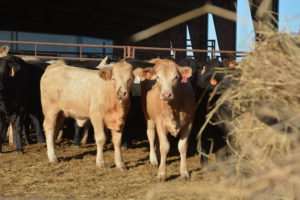By Blair Fannin
Though cattle prices have come down from historic highs, there are still ways for beef cattle producers to capture more dollars for their calves by adding value at the ranch, according to experts at the 45th South Central Texas Cow-Calf Clinic in Brenham.
Several hundred beef producers from Washington, Brazos, Austin, Burleson, Fayette, Harris, Lee and Waller counties took part in the day-long program hosted by the Texas A&M AgriLife Extension Service and surrounding beef and forage county committees.

Dr. Dan Hale, AgriLife Extension meat specialist, discussed carcass value and what cattle order buyers are looking for. He said there could be as many as nine order buyers at an auction ring looking to fill specific orders.
“What are those buyers looking at inside the auction ring?” Hale said. “They are looking at how fast those calves are going to gain once they leave the livestock market auction.”
He said it’s important to get as many buyers in attendance to bid on your cattle to fill their orders.
“You do that by making sure your calves you are marketing fit their orders,” he said.
Hale said the buyers are given orders every week before they go to the auction and may have as many as 20 orders to fill.
“If your calves fit at least one or two orders on each of the bidders present need to fill, then your cattle will potentially receive higher prices and maybe the top price of the day,” he said. “They are looking at frame size, the size of the animal and how large they are going to get before they start to get fat.”
Hale said the longer you can feed those animals before they start getting into the rapid fattening phase of their life, and the more muscular they are, the faster they grow.
“The order buyer is looking at seeing how long they will they grow in the feedyard or on grass before they start getting really fat,” he said. “This is also why lighter-weight calves often bring higher prices per hundredweight, as lighter cattle will be able to spend more time as a stocker calf and as a feeder calf before they become finished in the feedyard.
They also look at genetic makeup of the animal, and estimate the final USDA quality grade — USDA prime, choice or select — once the calf has gone through the feedyard and is a finished market animal.”
Hale said order buyers are also looking at gender. He said heifers start the fattening phase of their lives much sooner than steers and that is the reason prices paid for them are often less than comparable steers.
Hale said producers should consider adding value to their calves. This can be achieved by implementing programs such as the VAC 45 program, also known as the Value Added Calf program, where calves are weaned 45 days before they are sold. They also receive two sets of booster vaccines to enhance their immunity to disease and sickness.
The buyers of VAC 45 calves find them to more easily attain their genetic potential, have an enhanced immune system, are more predictable in their feedyard performance, and reduce the use of antibiotics.
Castrating bull calves also adds value, said Dr. Joe Paschal, Texas A&M AgriLife Extension Service livestock specialist, Corpus Christi. Paschal and Dr. Helen Philips of Philips Veterinary Hospital in Brenham provided a live chute-side demonstration.
“Talk to your veterinarian and develop what is referred to as a vet-client relationship,” Phillips told attendees. “Don’t wait until your calves are too sick to call a veterinarian.”
Click here to see more...